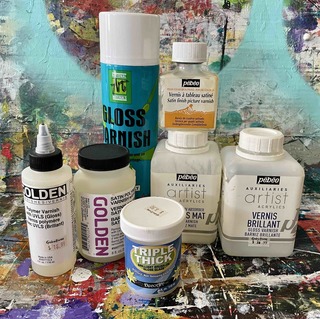Advice: Varnish or not to Varnish Your Artwork?
As an artist myself, I'm often asked about one particular step in the painting process: varnishing. It's something that can feel a little intimidating at first, especially when you've poured your heart into a piece and don't want to risk ruining it.
But varnishing isn't just a final flourish. It's essential to preserving and enhancing your work. Whether you paint in bold colours like I do or prefer subtle textures and soft details, knowing how and why to varnish can make a world of difference in both presentation and longevity.
"What exactly is varnish? Do I need to use it? How do I apply it without ruining my painting?"
If you've ever worried about this, you're not alone. I had the same concerns when I started out. But once you understand the process and the why behind it, varnishing becomes a satisfying and essential final step in your art-making journey.
What Is Varnish and Why Should You Use It?
Varnish is a transparent, protective layer that you apply to a finished painting. Think of it as a topcoat or sealant, like the clear gloss on your nails or the lacquer layer used on furniture. It doesn't just enhance your work aesthetically; it also acts as a protective barrier.
Here's what a good varnish does:
- Unifies surface sheen – Paintings often dry with inconsistent shine; varnish evens that out.
- Increases colour depth – Colours appear richer and more vibrant after varnishing.
- Protects against dust, dirt, and grease – Varnish makes your artwork easier to clean.
- Shields from UV damage – Many modern varnishes contain UV stabilisers to reduce fading from sunlight.
- Adds a professional finish – Gallery-ready appearance matters, especially when you're selling your work or entering exhibitions.
For artists like me who paint in bold colours and expressive textures, varnishing makes the artwork sing. Those colours just glow under the right finish.
When Is the Right Time to Varnish?
This depends on the medium you're using. The wrong type like an acrylic varnish for an oil painting can be detrimental just as it is for mixing oil and acrylic paint. Varnishing too soon is a common mistake and can lead to long-term issues like fogging, cracking, or yellowing.
Acrylic Paintings:
Acrylics tend to dry relatively fast, but drying and curing are different things. You should wait at least 72 hours, and ideally up to a week if your layers are thick or heavily textured.
Oil Paintings:
This is where patience is truly a virtue. Oils are cured by oxidation, not evaporation, which takes them much longer. to dry
- Thin layers – Wait at least 6 months.
- Impasto or heavy texture – Wait 9–12 months, minimum.
Test if your oil painting is dry using the thumbnail test: Gently press your nail into the thickest part of the paint. If it leaves an indent, it's not ready.
Types of Varnish: Which One Should You Choose?
Finish Options:
- Gloss – Reflective, makes colours more saturated and contrast higher. Great for vibrant, high-impact work.
- Satin – A balance between gloss and matte. Slight sheen without the shine.
- Matte – Non-reflective, gives a soft, velvety look but may reduce vibrancy.
Be aware that matte and satin varnishes contain matting agents, which can slightly cloud finer details or soft edges in your painting. Always test first if your art piece has delicate linework or intricate layers that you want to be seen.
Application Method:
- Brush-on varnish – Great control for textured surfaces or when you want to feel the process.
- Spray varnish – Easier to apply without brush strokes, ideal for flat or delicate work.
Personally, I like to use brush-on gloss for most of my work; it enhances the colours beautifully. I use satin or matte for pieces where shine might distract from subtle textures.

Removable vs Permanent Varnishes
You should always choose a removable, archival-quality varnish. That means it can be taken off later without damaging the painting underneath.
Why is this important?
- Over time, all varnish will eventually attract dirt, yellow slightly, or lose its clarity.
- A removable varnish can be cleaned away by a conservator and replaced with a fresh layer—prolonging the life and clarity of your artwork.
Look for labels that say things like: "Removable with [specific solvent]" or "Archival quality".
How to Apply Varnish: Step-by-Step Guide
Step 1: Prepare the Surface
- Your artwork must be completely dry.
- Remove all dust, pet hair, lint, or anything that might get trapped under the varnish.
- Use a soft, lint-free cloth, soft brush, or a gentle air blower.
Step 2: Choose the Right Conditions
- Temperature: Room temp (18–22°C or 64–72°F) is ideal.
- Humidity: Avoid varnishing in high humidity, as it can cause cloudiness or blooming.
- Lighting: Natural light from the side or a raking light helps you spot missed areas or particles.
Step 3: Prepare Your Varnish
- Pour a small amount into a wide, shallow container (don't be tempted to dip your brush into the bottle).
- If the varnish is too thick, dilute it slightly with the manufacturer's recommended thinner (e.g., distilled water or mineral spirits—remember, not water for oil-based varnish!).
Step 4: Apply with a Clean Varnish Brush
- Use a high-quality, flat, synthetic brush (1-3 inches wide depending on canvas size).
- Start at one edge and work your way across in even strokes.
- Don't overwork areas or go back into wet varnish—it will streak or cloud.
- Watch for bubbles and smooth them out gently.
Optional: Spray Method
- Hold the can about 20–30 cm away.
- Spray in slow, sweeping, horizontal motions across the artwork.
- Let each layer dry fully before applying another.
Step 5: Multiple Coats
- Apply 2–3 thin coats instead of one thick one.
- Let each coat dry for 24 hours (or at least overnight).
- Alternate direction: first vertical, second horizontal, this makes sure of full, even coverage.
Step 6: Drying
Once you've applied your final coat of varnish, it's important to then let the artwork dry, keeping it flat in a clean, undisturbed space. This helps prevent any runs or drips from forming, especially if you've used a slightly thicker layer.
Avoid placing the piece near open windows, heaters, or areas with high foot traffic where dust, hair, or tiny airborne particles can easily settle onto the sticky surface. Even something as small as a floating fibre can ruin an otherwise perfect finish.
If you're concerned about dust or curious pets, a simple cardboard box tented over the artwork works surprisingly well as a dust cover. Just make sure it's roomy enough not to touch the surface. Patience here is key, leave it to dry completely, undisturbed, before moving or hanging the piece.
Pro Tips for Flawless Varnishing
- Never shake the varnish bottle or can, gently stir instead to avoid bubbles.
- Keep a separate set of tools just for varnishing (brush, container, stirrer).
- Clean your brush immediately after use with the appropriate solvent.
- If you're unsure, test everything on a small sample board before applying it to the final work.
- Don't rush the process—each step is worth taking the time to do right.
Final Thoughts about varnishing artwork
Varnishing isn't just the final, finishing touch; it's a layer of care and intention that says this painting actually matters. It protects your creativity and effort and makes sure that your work will last for years if not generations.
Don't be afraid to experiment with different types of varnishes until you find your favourite one. Like most things in art, it's all about what works for your style, your medium, and your personal touch.
If you're ever unsure or need help choosing products, feel free to reach out. I'm always happy to share what's worked for me—and what hasn't!
Happy varnishing!
